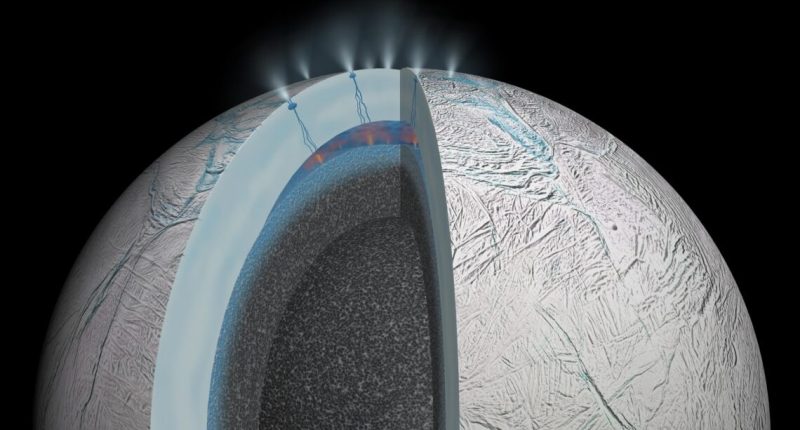A NASA probe could identify alien life from just a single grain of ice.
Alien-hunting tools are now so advanced that scientists say that even a tiny sample could give the extraterrestrials away.
Scientists have long hoped that some form of alien life could be lurking on icy moons in our Solar System like Saturn’s Enceladus or Jupiter’s Europa.
These moons can project plumes of ice into space that can be captured by passing Nasa probes.
Future missions – including one Nasa craft launching later this year – could find hard evidence of alien life using this technique.
“For the first time we have shown that even a tiny fraction of cellular material could be identified by a mass spectrometer onboard a spacecraft,” said Fabian Klenner, of the University of Washington in Seattle.
“Our results give us more confidence that using upcoming instruments, we will be able to detect lifeforms similar to those on Earth,” continued Klenner, the lead author and postdoctoral researcher in Earth and space sciences.
“Which we increasingly believe could be present on ocean-bearing moons.”
PLUME PROBE
Scientists previously found cracks near the south pole of Enceladus thanks to the Cassini probe.
It discovered plumes of gas and ice grains being blasted out from the moon.
Most read in Science
In October, Nasa’s Europa Clipper is expected to launch in a bid to probe Jupiter’s moon Europa.
And it will carry extra instruments to analyze the moon in greater detail than ever before.
Its Surface Dust Analyzer should be able to detect cellular material even in a single ice grain out of hundreds of thousands.
EASY CELL!
Scientists have tested their tools on a bacteria called Sphingopyxis alaskensis, which lives in waters off Alaska.
It’s a single-celled organism that survives in cold environments with few nutrients.
“They are extremely small, so they are in theory capable of fitting into ice grains that are emitted from an ocean world like Enceladus or Europa,” Klenner explained.
The instruments were able to detect the bacteria in a single grain of ice.
And they think that evidence of alien life could survive in ice grains ejected as part of a plume.
“With suitable instrumentation, such as the Surface Dust Analyzer on NASA’s Europa Clipper space probe, it might be easier than we thought to find life, or traces of it, on icy moons,” said Professor Frank Postberg, of the Freie Universität Berlin.
Enceladus – the key facts
Here’s what you need to know…
- Enceladus is Saturn’s sixth-largest moon, with a diameter of 310 miles
- It’s roughly one-tenth the size of Saturn’s largest moon, Titan
- The moon is largely covered by fresh and clean ice, making it highly reflective
- This also means it’s very cold, with surface temperatures at noon reaching -198C
- The moon was first discovered by British astronomer William Herschel on August 28, 1789
- But we learned much more about it after Voyager 1 and Voyager 2 spacecraft fly-bys. in the 1980s
- In 2014, Nasa found evidence to suggest there was a large subsurface ocean of liquid water on Enceladus
- And in 2018, scientists discovered complex macromolecular organics on the moon’s jet plumes
- This has given scientists hope for finding evidence of alien life on the moon
“If life is present there, of course, and cares to be enclosed in ice grains originating from an environment such as a subsurface water reservoir.”
The Europa Clipper is expected to launch in October 24 to study Europa.
READ MORE SUN STORIES
It will make a series of flybys while orbiting around Jupiter as part of a 5.5-year mission.
Nasa has opted to use Elon Musk’s SpaceX Falcon Heavy rocket to launch the probe during a 21-day window.













